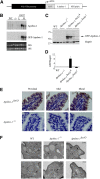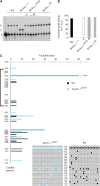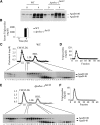Intestine-specific expression of Apobec-1 rescues apolipoprotein B RNA editing and alters chylomicron production in Apobec1 -/- mice
- PMID: 22993231
- PMCID: PMC3494256
- DOI: 10.1194/jlr.M030494
Intestine-specific expression of Apobec-1 rescues apolipoprotein B RNA editing and alters chylomicron production in Apobec1 -/- mice
Abstract
Intestinal apolipoprotein B (apoB) mRNA undergoes C-to-U editing, mediated by the catalytic deaminase apobec-1, which results in translation of apoB48. Apobec1(-/-) mice produce only apoB100 and secrete larger chylomicron particles than those observed in wild-type (WT) mice. Here we show that transgenic rescue of intestinal apobec-1 expression (Apobec1(Int/O)) restores C-to-U RNA editing of apoB mRNA in vivo, including the canonical site at position 6666 and also at approximately 20 other newly identified downstream sites present in WT mice. The small intestine of Apobec1(Int/O) mice produces only apoB48, and the liver produces only apoB100. Serum chylomicron particles were smaller in Apobec1(Int/O) mice compared with those from Apobec1(-/-) mice, and the predominant fraction of serum apoB48 in Apobec1(Int/O) mice migrated in lipoproteins smaller than chylomicrons, even when these mice were fed a high-fat diet. Because apoB48 arises exclusively from the intestine in Apobec1(Int/O) mice and intestinal apoB48 synthesis and secretion rates were comparable to WT mice, we were able to infer the major sites of origin of serum apoB48 in WT mice. Our findings imply that less than 25% of serum apoB48 in WT mice arises from the intestine, with the majority originating from the liver.
Figures









Similar articles
-
Induction of body weight loss through RNAi-knockdown of APOBEC1 gene expression in transgenic rabbits.PLoS One. 2014 Sep 12;9(9):e106655. doi: 10.1371/journal.pone.0106655. eCollection 2014. PLoS One. 2014. PMID: 25216115 Free PMC article.
-
Alternative mRNA splicing and differential promoter utilization determine tissue-specific expression of the apolipoprotein B mRNA-editing protein (Apobec1) gene in mice. Structure and evolution of Apobec1 and related nucleoside/nucleotide deaminases.J Biol Chem. 1995 Jun 2;270(22):13042-56. doi: 10.1074/jbc.270.22.13042. J Biol Chem. 1995. PMID: 7768898
-
Superior role of apolipoprotein B48 over apolipoprotein B100 in chylomicron assembly and fat absorption: an investigation of apobec-1 knock-out and wild-type mice.Biochem J. 2001 Jun 15;356(Pt 3):821-7. doi: 10.1042/0264-6021:3560821. Biochem J. 2001. PMID: 11389690 Free PMC article.
-
APOLIPOPROTEIN B: mRNA editing, lipoprotein assembly, and presecretory degradation.Annu Rev Nutr. 2000;20:169-93. doi: 10.1146/annurev.nutr.20.1.169. Annu Rev Nutr. 2000. PMID: 10940331 Review.
-
Apolipoprotein B: from editosome to proteasome.Recent Prog Horm Res. 2000;55:93-125; discussion 126. Recent Prog Horm Res. 2000. PMID: 11036935 Review.
Cited by
-
Epithelial Indoleamine 2,3-Dioxygenase 1 Modulates Aryl Hydrocarbon Receptor and Notch Signaling to Increase Differentiation of Secretory Cells and Alter Mucus-Associated Microbiota.Gastroenterology. 2019 Oct;157(4):1093-1108.e11. doi: 10.1053/j.gastro.2019.07.013. Epub 2019 Jul 17. Gastroenterology. 2019. PMID: 31325428 Free PMC article.
-
PCSK9 deficiency reduces atherosclerosis, apolipoprotein B secretion, and endothelial dysfunction.J Lipid Res. 2018 Feb;59(2):207-223. doi: 10.1194/jlr.M078360. Epub 2017 Nov 27. J Lipid Res. 2018. PMID: 29180444 Free PMC article.
-
Reassessment of murine APOBEC1 as a retrovirus restriction factor in vivo.Virology. 2014 Nov;468-470:601-608. doi: 10.1016/j.virol.2014.09.006. Epub 2014 Oct 7. Virology. 2014. PMID: 25303118 Free PMC article.
-
Identification of RBM46 as a novel APOBEC1 cofactor for C-to-U RNA-editing activity.J Mol Biol. 2023 Dec 15;435(24):168333. doi: 10.1016/j.jmb.2023.168333. Epub 2023 Oct 29. J Mol Biol. 2023. PMID: 38708190 Free PMC article.
-
From worms to humans: Understanding intestinal lipid metabolism via model organisms.Biochim Biophys Acta Mol Cell Biol Lipids. 2023 Apr;1868(4):159290. doi: 10.1016/j.bbalip.2023.159290. Epub 2023 Feb 3. Biochim Biophys Acta Mol Cell Biol Lipids. 2023. PMID: 36738984 Free PMC article. Review.
References
-
- Chen Z., Davidson N.O.2006. Genetic regulation of intestinal lipid transport and metabolism. In Physiology of the Gastrointestinal Tract. L. R. Johnson, editor. Elsevier Academic Press, Boston, MA. 1711–1734.
-
- Teng B., Burant C. F., Davidson N. O. 1993. Molecular cloning of an apolipoprotein B messenger RNA editing protein. Science. 260: 1816–1819 - PubMed
-
- Lellek H., Kirsten R., Diehl I., Apostel F., Buck F., Greeve J. 2000. Purification and molecular cloning of a novel essential component of the apolipoprotein B mRNA editing enzyme-complex. J. Biol. Chem. 275: 19848–19856 - PubMed
Publication types
MeSH terms
Substances
Grants and funding
LinkOut - more resources
Full Text Sources
Molecular Biology Databases
Miscellaneous

